Aluminium Design and Construction - Chapter 2 potx

Aluminium Design and Construction - Chapter 2 potx
... 1.0, 1 .2, 1.5, 2. 0, 2. 5, 3.0, 4.0, 5.0 and 6.0 mm. Most sheet is produced in non-heat-treatable material (1xxx, 3xxx, 5xxx), and is supplied in a stated temper (such as ‘quarter-hard’, ‘half- hard’) ... applications, sheet is supplied in heat-treatable alloy (2xxx, 6xxx or 7xxx series), usually in the fully-heat-treated T 6- condition (quenched and artificially aged). 2. 2.4 To...
Ngày tải lên: 22/07/2014, 18:22
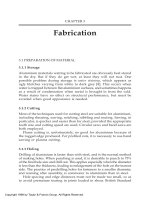
Aluminium Design and Construction - Chapter 3 potx
... for non-aeronautical use are usually in the stronger kind of 6xxx-series alloy. They can be either machined from T6-condition bar-stock, or forged and then artificially aged (T8-condition). Design data ... Gadarene. Non-heat-treatable solid aluminium rivets come in 5xxx-series alloy. For the best shear strength, they should be supplied in a work-hardened condition (typically quarter-har...
Ngày tải lên: 22/07/2014, 18:22

Aluminium Design and Construction - Chapter 12 ppt
... defined are 60, 50, 42, 35, 29 , 24 , 20 , 17, 14. The class for a given detail may be found by referring to the relevant table, based on BS.8118: Table 12. 2 non-welded details; Table 12. 3 welded details, ... TIG. 12. 2 POSSIBLE WAYS OF HANDLING FATIGUE There are three possible approaches for checking a proposed design against failure by fatigue: 1. safe life method; 2. fail-safe met...
Ngày tải lên: 22/07/2014, 18:22

Aluminium Design and Construction - Chapter 11 docx
... at 25 °C. 3. Columns 3 and 4 give the room temperature curing time to achieve =1 and =10 N/mm 2 , when tested at 23 °C. 4. Columns 5 and 6 give typical average strengths when tested at 23 °C and ... when the 0 .2% proof stress of the plates is less than 23 0 N/mm 2 .) High-strength friction-grip joints must be checked for the ultimate limit state, as with non-torqued fasteners...
Ngày tải lên: 22/07/2014, 18:22

Aluminium Design and Construction - Chapter 10 pps
... using equation (10 .29 ). The summations in equations (10 .28 ) and (10 .29 ) may conveniently be made for the elements in one half of the section (as shown numbered), and then doubled. Skew-radial-symmetric ... are bisymmetric, radial-symmetric or skew-symmetric S coincides with G and g=0. For sections entirely composed of radiating outstand elements, such as angles and tees (‘type-R...
Ngày tải lên: 22/07/2014, 18:22
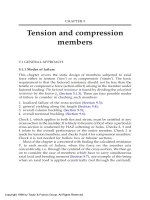
Aluminium Design and Construction - Chapter 9 docx
... checks A and B tend to be oversafe when applied to fully-compact profiles, and for these a more realistic result can be obtained by using a direct plastic calculation instead: (9 .22 a) (9 .22 b) ... nomogram: x 3 -3 x 2+ Ax-B=0 (9.15) where 9.6.9 Torsional buckling of struts containing very slender outstands When the section contains very slender outstands (Section 7 .2....
Ngày tải lên: 22/07/2014, 18:22
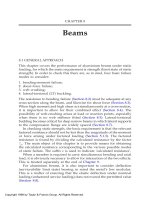
Aluminium Design and Construction - Chapter 8 doc
... yield stress and the 0 .2% proof stress respectively for the two materials. Typically, the diagram might be looked on as comparing mild steel and 60 8 2- T6 aluminium. Moment levels Zp ° and Sp ° ... sophisticated treatment [26 ]. Figure 8.1 Comparison of the curves relating bending moment M and curvature 1/R for steel (1) and aluminium (2) beams of the same section and yiel...
Ngày tải lên: 22/07/2014, 18:22
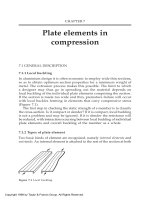
Aluminium Design and Construction - Chapter 7 pps
... element. Stress-pattern at failure, and assumed effective section. N=non-welded, W=with edge-welds. Figure 7.5 Slender outstand. Stress- pattern at failure, and assumed effective section. N=non-welded, ... outstands is similar, but with a different ß-scale (about one-third). The scatter shown in the figure results from random effects including initial out-of-flatness and shape of the st...
Ngày tải lên: 22/07/2014, 18:22

Aluminium Design and Construction - Chapter 6 pptx
... non-heat-treatable material there is negligible dip at A, and k z3 =k z1 . 6.4 .2 Heat-treated material Table 6.1 lists proposed k z -values for MIG-welded joints in 6xxx and 7xxx-series alloys. These have generally ... 0.8x B (6.1b) 6.3 .2 Work-hardened material With the non-heat-treatable alloys, HAZ softening need only be consid- ered for work-hardened material; it is not a factor wi...
Ngày tải lên: 22/07/2014, 18:22
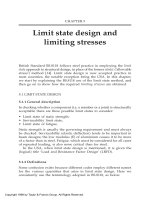
Aluminium Design and Construction - Chapter 5 pps
... table relates to equations (5.6), (5.7). 2. The resulting families of design curves are presented as follows: LT, Figure 8 .22 ; C1, 2, 3, Figure 9 .2; T1, 2 Figure 9.9. Copyright 1999 by Taylor & ... appropriate scatter-band, with a cut-off at the limiting stress for the material. Local buckling of a thin-walled cross-section, as distinct from overall buckling of the member as a wh...
Ngày tải lên: 22/07/2014, 18:22
- design and construction of lpg installations
- api std 2510 design and construction of lpg installations
- api standard 2510 design and construction of lpg installations
- api std 2510 design and construction of liquefied petroleum gas installations lpg
- american petroleum institute api 2510 design and construction of lpg installations
- the nature of science and technology chapter 2
- code of practice for design and construction
- steel rigid frames manual design and construction